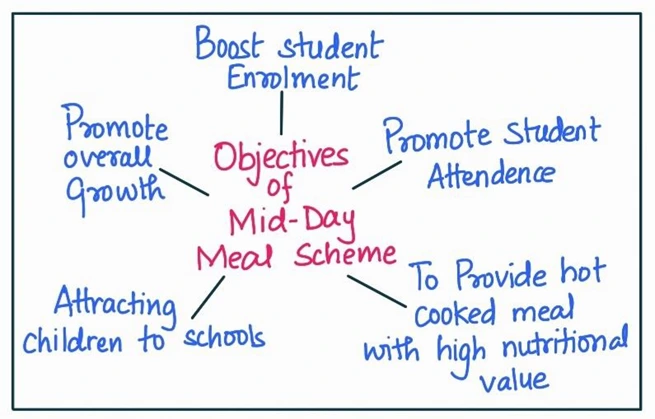Answer:
| Approach:
Introduction
- The introduction would present a brief background of the Mid Day Meal Scheme (MDM), highlighting its origins in pre-independent India and its revitalization in the last two decades.
Body
- Discuss the two primary objectives of the MDM – enhancing nutritional intake and boosting school enrollment and attendance.
- Focus on the recent mandates related to the MDM, including its extension to upper primary classes and the 2013 Supreme Court direction to provide mid-day meals during the summer vacation.
- Critically examine the success of the MDM in achieving its objectives, substantiated with relevant examples.
- Substantiate with appropriate examples.
Conclusion
- Summarize the key points made in the body of the answer, acknowledging the significant strides made by the MDM in improving children’s nutritional status and school participation.
|
Introduction:
The Mid Day Meal Scheme (MDM) is a significant government initiative in India aimed at enhancing the nutritional status and educational attainment of school-age children. Initiated in the Madras Presidency during pre-independent India, the scheme has been revitalized in most states in recent decades.
Body:
Twin Objectives of MDM:

- Enhancing Nutritional Intake:
- The MDM aims to improve the nutritional status of children in government and government-aided schools across the country.
- It does so by providing free, nutritious meals to children, thus ensuring at least one balanced meal a day.
- The meal typically consists of a combination of cereals, pulses, vegetables, and sometimes even fruit, aiming to provide a minimum amount of calories, proteins, and other essential nutrients.
- For example, the prescribed nutritional content is 450 calories and 12 grams of protein for primary school children, and 700 calories and 20 grams of protein for upper primary school children.
- Undernourishment and malnutrition are prevalent issues among Indian children, and providing a nutritious meal during the school day can significantly improve their health and well-being.
- Boosting School Enrollment and Attendance:
- The scheme serves as an incentive for families to send their children to school.
- By providing a free meal, it aims to increase enrollment rates, reduce dropouts, and ensure regular attendance, especially in rural and economically backward areas.
- The scheme is based on the premise that hunger should not be a barrier to education.
- By ensuring that children are fed at school, parents, especially from low-income families, are more likely to send their children to school rather than keep them at home or use them for work.
- In this way, the Mid Day Meal Scheme contributes to increasing literacy rates and improving the overall educational scenario in the country.
Latest Mandates:
In recent years, there have been several important mandates related to the MDM. The scheme has been extended to upper primary classes in government, government-aided, and local body schools. In 2013, the Supreme Court directed all states to provide a mid-day meal during the summer vacation to prevent child malnutrition.
Success and Impact of MDM:
- The Mid Day Meal Scheme has had a significant impact on children’s health and education in India. Studies have shown that it has led to an increase in school enrollment and attendance, particularly among girls. For instance, in Rajasthan, the MDM scheme reportedly led to a 20% increase in girls’ enrollment.
- Additionally, the scheme has had a positive impact on children’s nutritional status. A study in Andhra Pradesh found that children receiving mid-day meals showed a reduction in malnutrition levels.
- However, the scheme has faced challenges, including issues of food quality and safety, irregularity in meal distribution, and corruption. The tragic incident in Bihar in 2013, where 23 children died after consuming contaminated food served under the MDM, underscores the need for stringent quality controls.
Conclusion:
While the Mid Day Meal Scheme has made significant strides in achieving its twin objectives, continuous monitoring, evaluation, and improvements are required to overcome existing challenges. The scheme is a testament to how policy interventions can address critical issues of nutrition and education, thereby contributing to the nation’s overall development.
